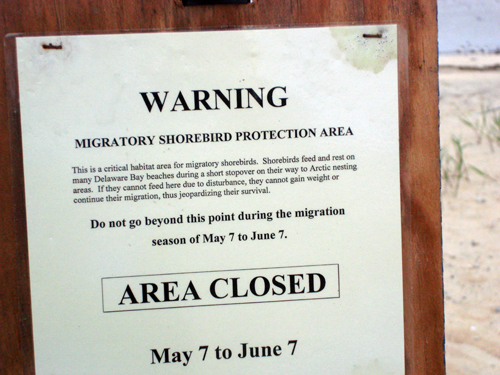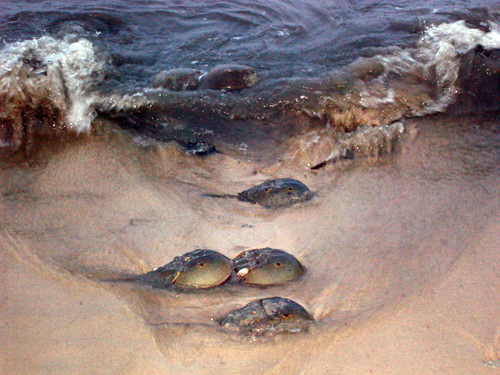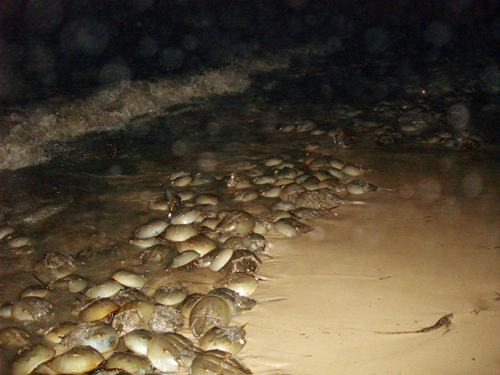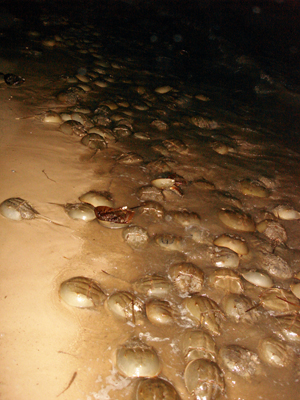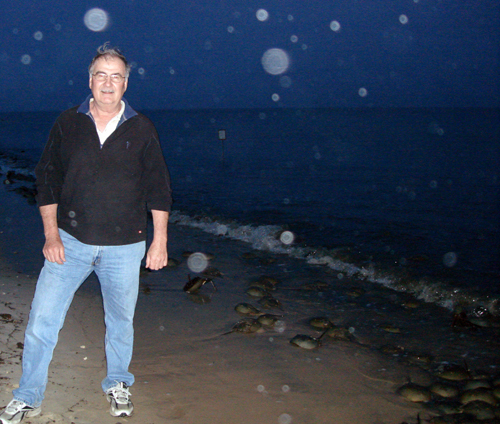Delaware • New Jersey • Pennsylvania
New York • United States of America
It's mid-spring, the time of year when horseshoe crabs emerge from the depths of the ocean to lay their eggs on the beaches of the Delaware Bay. Horseshoe crabs are ancient creatures, over 300 million years old, older than the dinosaurs. Each year, Delaware Bay beaches host more breeding horseshoe crabs than anywhere else in the world.
When horseshoe crabs wash ashore in the surf, sometimes they become overturned by waves or trapped in jetties or behind bulkheads. These situations can prove dangerous for the crabs, leading many to become stranded, vulnerable to predators and exposure. One partnership, reTURN the Favor New Jersey, collaborates with several organizations, for example, the Bayshore Center at Bivalve, and individual volunteers to walk New Jersey's public, but seasonally closed, Delaware Bay beaches during spawning season (May-June) to help rescue overturned or trapped crabs.
On the evening of Wednesday, May 14, 2014, DRBC Deputy Director Bob Tudor volunteered his time with reTURN the Favor and the Bayshore Center at Bivalve to help rescue stranded horseshoe crabs by walking Moores Beach. During his shift under the light of the full moon, Bob rescued over 450 horseshoe crabs! You too can volunteer; click here to learn more.
View additional photos on DRBC's Flickr page.
View NBC 40 news story "ReTURN the Favor to save horseshoe crabs" dated May 4, 2014.
Timing their arrival to that of the horseshoe crabs, hundreds of thousands of migrating shorebirds land on the beaches of the Delaware Bay. The birds are tired and starving, having flown for thousands of miles from South and Central America where they spent the winter. Their stop at the bay is only temporary, two weeks of rest and refueling on the eggs laid by the horseshoe crabs. The fat-rich eggs help the birds regain bulk and provide the energy needed for the last leg of their journey, a non-stop, two thousand miles to their Arctic breeding grounds.
Horseshoe crabs and shorebirds are ecologically linked. The crab's eggs are crucial to the birds' survival; depleted of fat reserves on arrival, many will double, sometimes triple, their body weight during their Delaware Bay layover, which is one of the largest staging areas for shorebirds in North America.
Unfortunately, reduced numbers of horseshoe crabs over the years have threatened some species of shorebirds, for example the red knot. Reduced numbers of eggs for these birds to eat means that they cannot refuel adequately for their journey to the Arctic and therefore less are breeding. Red knots are listed as endangered in New Jersey and are currently a candidate for federal endangered species listing.
Efforts to increase shorebird numbers began in 2000 with catch limits on harvesting horseshoe crabs imposed by the Atlantic States Marine Fisheries Commission. In 2008, New Jersey issued a moratorium on catching horseshoe crabs; this moratorium is still in effect today.
DRBC's page of horseshoe crab and shorebird links
Volunteer to help scientists count horseshoe crabs and shorebirds on the Delaware Bay:
- Horseshoe Crab 2014 Survey Information (includes contacts for Delaware and New Jersey)
- Delaware Shorebird Project 2014 Volunteer Information
Recent News Articles:
- "Along Delaware Bay, tracking the shorebirds" - Article in the May 20, 2014 edition of the Philadelphia Inquirer by Sandy Bauers
- "Horseshoe crab count underway on East Coast" - Article dated May 16, 2014 from the National Geographic Daily News online
- "Beach rehab project targets the other Jersey shore" - Article dated May 11, 2014 by AP reporter Wayne Parry
- "Beach replenishment in time for crab spawn, red knot migration" - Article in the May 9, 2014 edition of the Philadelphia Inquirer by Jaqueline L. Urgo
Copyright © Delaware River Basin Commission,
P.O. Box 7360, West Trenton, NJ 08628-0360
Phone (609)883-9500; Fax (609)883-9522
Thanks to NJ for hosting the DRBC website
